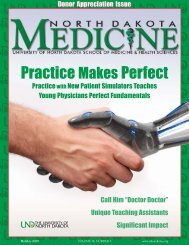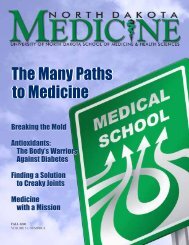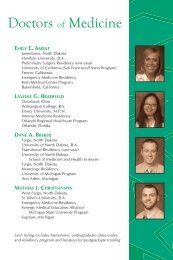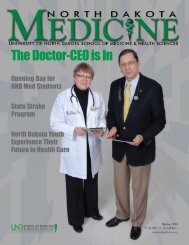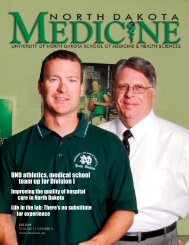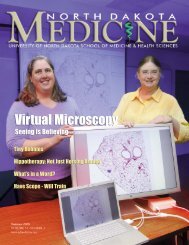Touching Lives Touching Lives - North Dakota Medicine
Touching Lives Touching Lives - North Dakota Medicine
Touching Lives Touching Lives - North Dakota Medicine
Create successful ePaper yourself
Turn your PDF publications into a flip-book with our unique Google optimized e-Paper software.
symptoms. He found that patients who<br />
live closer to the pollen counter in<br />
Fargo had more severe symptoms.<br />
A pollen counter looks like a<br />
weathervane, with a slide that collects<br />
pollens in the air, Fenstad says. Dalan<br />
reads them and reports the data to the<br />
National Allergy Bureau which disperses<br />
the information through allergy<br />
websites and news outlets. Based on<br />
this data, doctors can assess the pollen<br />
threat and make recommendations to<br />
their patients about how to treat their<br />
allergy symptoms in advance of a rise<br />
in the pollen count.<br />
However doctors who practice outside<br />
Fargo don’t have local pollen count<br />
records to help them advise and treat<br />
patients; they must rely on past records<br />
and generalized information. Fenstad is<br />
hoping his study helps to “raise<br />
awareness that there aren’t enough<br />
pollen counters,” he says. But “right<br />
now, it’s the best tool we have.”<br />
Dalan advised him on how to analyze<br />
and present data at the national<br />
meeting of the AAAAI which updates<br />
allergy specialists from around the<br />
world on new research advances.<br />
Fenstad attended the meeting, all<br />
expenses paid, under the Chrysalis<br />
program, which introduces students to<br />
the life of an allergist.<br />
“It was an awesome experience,” he says.<br />
“It gives you more insight into allergy<br />
medicine prior to committing to the field.”<br />
Dalan, who conducts numerous studies<br />
related to the practice of allergy<br />
medicine in an agricultural area and<br />
other issues, praises Fenstad for taking<br />
the initiative and seeking him out to do<br />
research, he says. “It was a natural<br />
progression for him to do research<br />
that’s relevant to our area.”<br />
Therapeutic hypothermia<br />
For another study, this one in<br />
cardiology, Fenstad re-connected with<br />
Tim Henry, MD (BS Med ’80), director<br />
of research at the Minneapolis Heart<br />
Institute and world-renowned<br />
cardiologist with whom he had worked<br />
before enrolling in medical school.<br />
(Henry is originally from Mohall, ND.)<br />
During a cardiology rotation, Fenstad<br />
was introduced by Henry to<br />
cardiologists who use therapeutic<br />
hypothermia to treat patients who’ve<br />
experienced sudden cardiac arrest.<br />
With this relatively new process, the<br />
body is cooled to between 32 and 34<br />
degrees Celsius as soon as possible<br />
after the arrest.<br />
For patients who suffer a sudden<br />
cardiac arrest, “the majority… do not<br />
survive,” Fenstad explains, “and those<br />
who do often have severe neurological<br />
deficits and cognitive impairment.”<br />
“ ”<br />
Research strengthened my ability<br />
to critically appraise the medical literature<br />
Studies have proven that “the quicker<br />
they can cool the patient down after the<br />
heart attack, the better the outcome, the<br />
metabolism slows down, the heart and<br />
brain don’t require as much oxygen –<br />
it’s protective to cool them,” Fenstad<br />
says. “These patients, with therapy,<br />
experience 40 to 50 percent<br />
improvement recovery in symptoms,<br />
and can become semi-independent.”<br />
Results of the first big trials of<br />
therapeutic hypothermia, released in<br />
2002, showed that the treatment<br />
effectively decreased mortality and<br />
improved neurologic outcomes, Fenstad<br />
says. His study sought to build on that<br />
knowledge by “looking at predictors of<br />
better outcomes such as patient<br />
characteristics,” like age, and other<br />
factors including the length of time<br />
between the cool-down and heart<br />
pumping action.<br />
Therapeutic hypothermia is starting to<br />
become standard treatment for patients<br />
with sudden cardiac arrest, he says. “It’s<br />
something I hope to implement when I<br />
come back to <strong>North</strong> <strong>Dakota</strong> eventually.”<br />
- Pamela D. Knudson<br />
NORTH DAKOTA MEDICINE Holiday 2008 23



